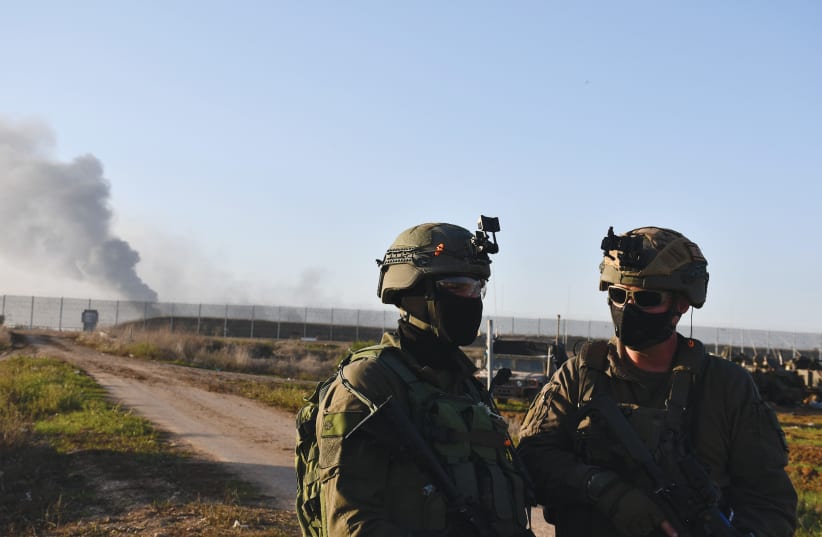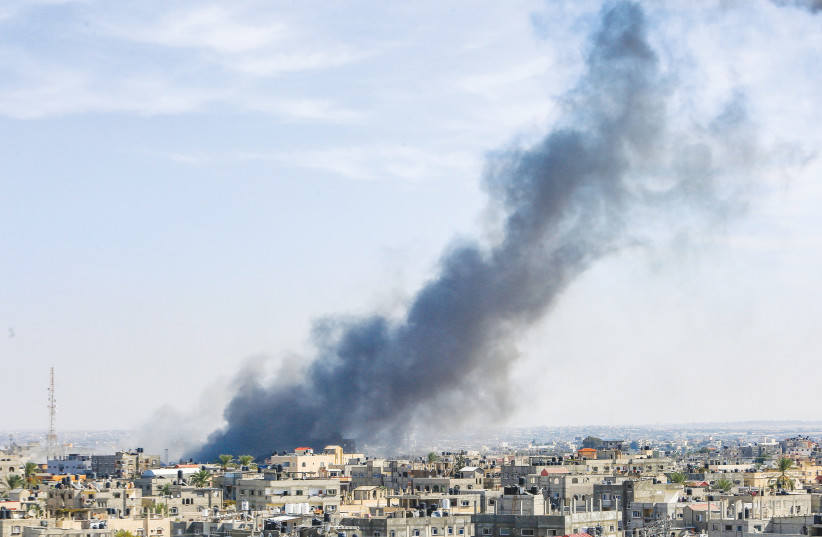When Hamas attacked Israel on October 7, it laid waste a swath of Israel near the border with Gaza. It attacked communities and massacred people. Few places near the border with Gaza were left unscathed.
I remember that first day, when I arrived near Yad Mordechai and the battles to stop Hamas were raging. What had been a well-defended border had crumbled. However, there was no static front line between Hamas and Israel.
Instead, there was chaos that first day. Between Gaza and the areas in Israel that were secure from the terrorists, there was a kind of no-man’s-land. When I first encountered it, I called it “zombieland.”
Eighty days into the war, this sense of a no-man’s-land still exists. Today, the no-man’s-land is on the other side of the border, in Gaza. The fence along the border has been rebuilt. However, not everything is well and good.
A trip to Gaza during the war
I drove down to Gaza on December 26. It was a warm day, like many of the December days have been. The border roads near Gaza have been opened now. The police checkpoints are mostly gone. The scars of war are also being visibly renovated, with street signs replaced and even signs indicating tourist sites put back up, with a fresh coat of paint. Residents are also coming back slowly to some communities. It almost seems normal.
It is not normal though. On the road from Sderot to Kibbutz Kfar Aza smoke rises in the background from fighting in northern Gaza. On October 7 these roads were taken over by terrorists, and the roads became scenes of death and massacre. Now I am driving toward Gaza, retracing the steps of massacre, in reverse. I drive toward the smoke, toward the war.
The war in Gaza
Since the war began I’d been trying to get into Gaza as an embed with an IDF unit. Due to timing, various invitations hadn’t worked out. However, this time it was different. I’d be going in with the IDF’s new Multidimensional Unit.
This is a unit that was created several years ago, bringing together combat soldiers from other special units to place them at the forefront of the IDF’s hi-tech. That means using drones and other systems to knit together all the sensors one might have on a battlefield, essentially sponging up information about enemies so soldiers can neutralize them faster. This could be attacking on the ground with infantry and tanks, or bringing in new precision mortars, called Iron Sting, or calling in airstrikes.
The Multidimensional Unit is called the “Ghost” unit. It is part of the IDF’s new 99th Division, which harnesses air power, combat engineers, infantry, and other systems to bring the fight to the enemy.
We arrived at a field near Gaza to meet the “Ghosts.” The unit was spread out not far from the Gaza border. Fighting was occurring in Jabalya, a mile or so inside the border. Smoke was billowing. The reconstructed fence, which was broken through by Hamas on October 7, was in front of us. We could hear outgoing mortar fire. Small quadcopter drones buzzed overhead, flying into Gaza and returning. In addition, the enemy was firing into Israel. Mortars slammed into a field near us, 100 meters away, churning up dirt. There were interceptions overhead.
We met in the field with officers from the “Ghost” unit. The soldiers are framed on one side by the fence and the smoke, the drones and the war. On the other side are pastoral scenes of green fields and solar panels for greenhouses. One side is peaceful. One side is war. These men are at the intersection of the two, making sure the enemy can no longer threaten Israel.
BACK IN 2020 when Israel rolled out its Momentum Plan for shifting how it fights wars, it described the challenge in an IDF document. “The IDF’s new understanding of the military challenge – Israel’s adversaries are ‘diffuse, rocket-based terror armies’ (i.e., not just guerrilla or terror organizations). The IDF must come to a new understanding of its enemies and reinvent itself in light of this understanding. That will be the focus of the first section of this article.”The “Ghost” unit and other new units were part of the reinvention.
Some of this has been critiqued recently because, in Israel’s pursuit of new tech and specialized units, it scaled back on the old big army. That meant less regular infantry and regular armored units. Less helicopters on standby ready for the fight, and more drones. October 7 has many ramifications. One is that specialized units with new technology are not enough against thousands of enemy terrorists. Another lesson is that the new technology needs to be expanded.
To get into Gaza we went to the security fence, along a dirt road, and then through a gate. In front of the gate is an earthen built-up area, with a concrete pillbox tower. Behind the tower are several armored vehicles. This is our chariot, in a sense, which awaits us. For us the chariot is a Namer armored personnel carrier.
A hulking beast of a machine that weighs dozens of tons, it looks like a tank on the bottom, with treads, but doesn’t have a turret on top. Instead, it has a machine gun and some other items festooning its roof. This is 60 tons of machine, and people are supposed to go into it and ride it into the battle. The goal, of course, is to protect the people inside.
The Namer was developed as a result of Israel possessing an aging fleet of M113 APCs that date from the Vietnam era. Vulnerable and slow, they needed to be retired. Eventually, the IDF developed the Namer and began providing it to the Givati and Golani infantry brigades. Now the IDF has a new generation APC, called the Eitan, which has giant wheels rather than tank treads. It is being issued to the Nahal infantry brigade.
For us it was the Namer. We piled into it, several journalists and soldiers, and the hatch on the back slammed shut. Now we were inside a metal box on treads. For the next 20 minutes or so we followed a tank into Jabalya until the vehicle finally backed up into a kind of yard that had become a tank parking lot, surrounded by three buildings. The hatch opened and we were in Gaza. We had advanced through “zombieland” into a war zone.
Here the soldiers of the “Ghost” unit met us and showed us around their area of operations. They had secured the houses here and were collecting intelligence about the area. A drone lifted off. A donkey wandered among the tanks and our Namer chariot. The donkey had been sort of adopted by the unit. They called it Shrek.
The soldiers were enthusiastic about their mission. They described the unit’s unique abilities. It can gather information quickly, using new technologies, and then bring in airstrikes or other firepower against threats.
When we’d arrived, it was light, but the light was fading as the sun began to dip below the horizon. From our position we could see out over Gaza City toward the Mediterranean. Over an earthen berm, covered with broken trees and deformed metal, the power plant near Ashkelon could be seen. It was close, but so far away.
Between us and Ashkelon was a battlefield and the remnants of a Hamas terrorist empire that once lay beneath the surface here. Surely much of that terrorist infrastructure remained, but the IDF was removing it bit by bit.
This unit had eliminated 86 terrorists so far. It has been fighting since October 7. Several members of the unit were killed on October 7 and in subsequent clashes.
The “Ghost” unit works with other elite units, such as Duvdevan and Maglan. In Jabalya it was fighting under the 162nd Division, which has been hammering Hamas in northern Gaza. South of them is the 36th Division, which is fighting in Shejaia. The goal of the “Ghost” unit is to bring game-changing technology to the front line. This is what the unit trained for over the last several years. It was involved in the operations in Gaza in 2021, but this is its longest war so far.
The specialized technology, such as drones, is useful against a terrorist enemy that hides underground. The enemy has gone to ground in Gaza, in this sense, and is now trying to wage a guerrilla war against Israel. Now is the time for specialized elite units like the “Ghosts” to use their technology to be a force multiplier against an unseen enemy.
The experience in Gaza was important to see how the war is progressing. More than 80 days into the war, the IDF is fighting in neighborhoods where it has fought in the past. In previous wars the IDF had to operate in Jabalya; in 2009, during Operation Cast Lead, it operated in neighborhoods throughout Gaza. The challenge today is that these neighborhoods have been festooned with more tunnels, and Hamas, since it took control of Gaza in 2007, has had a decade and a half to prepare for fighting Israel.
The area where we were was deserted of civilians. The roads had been chewed up by armored vehicles. Tracked vehicles don’t like to drive on roads anyway; they prefer dirt. The area above ground appeared uninhabited now, but it is not clear whether the area below ground has been cleared completely of terrorists.
The mortar fire targeting the border before we embarked appeared to indicate that cells of terrorists continue to operate. The new technology of drones and elite units should enable the IDF to track down these cells and neutralize them.
When darkness came we piled back into the Namer and took the journey out, escorted again by tanks. When we arrived back at the tower near the border, it was dark, and the border fence loomed large.
For a second, being deposited by the fence in the dark, coming out of the disconcerting, cramped APC, into an unfamiliar area at night, it was not clear whether we were on the Israeli or Gaza side of the border. Either way, we knew we were heading away from this middle area, this “zombieland,” back to the land of the living.

